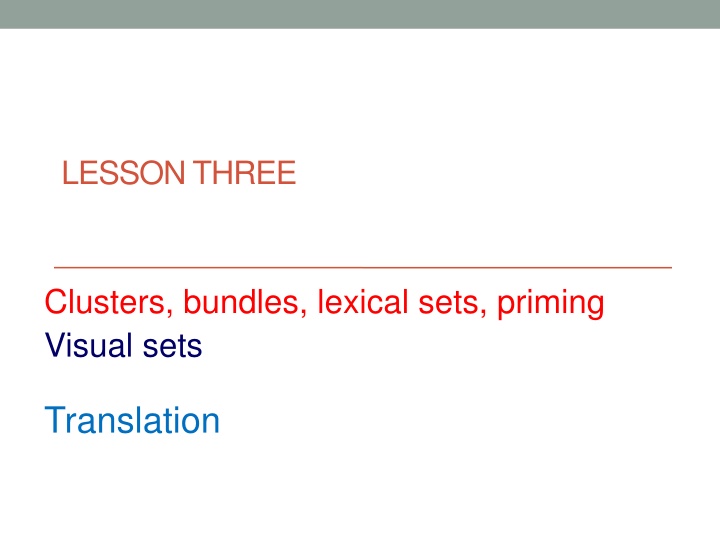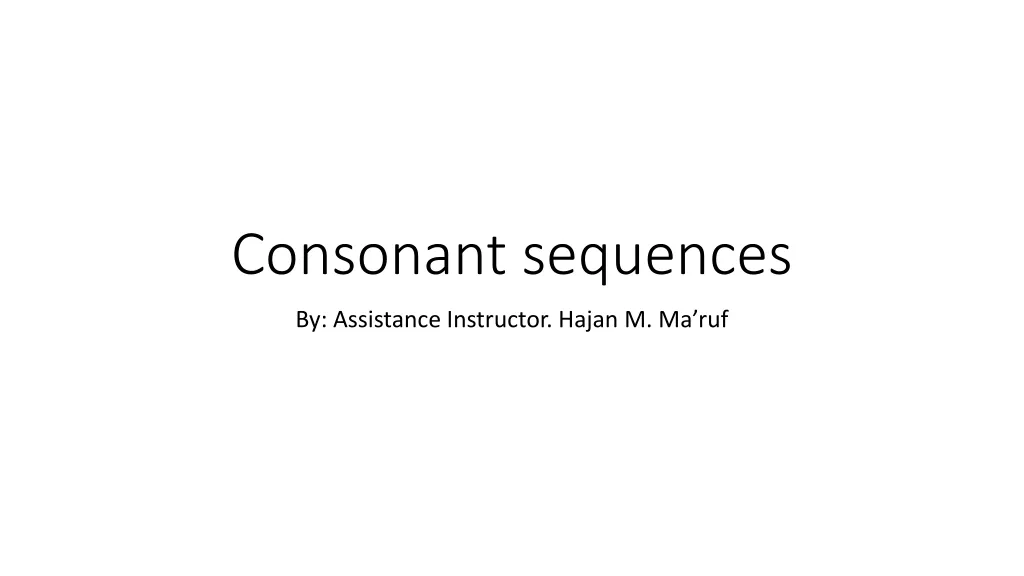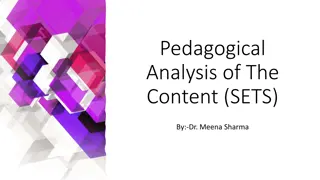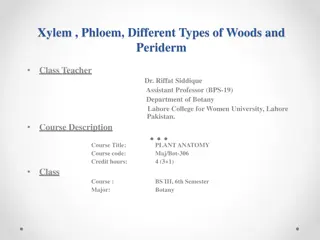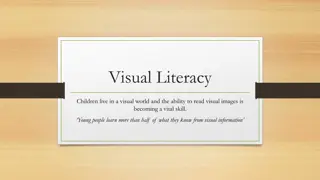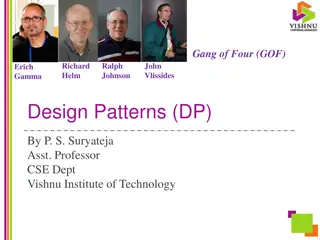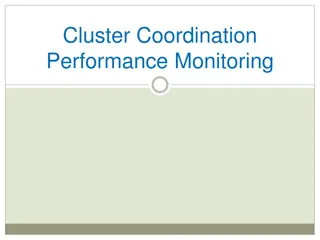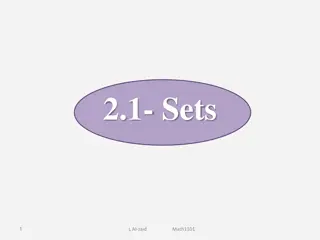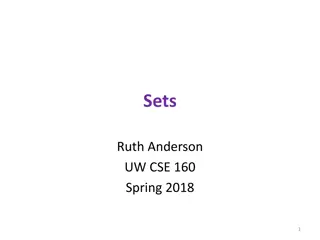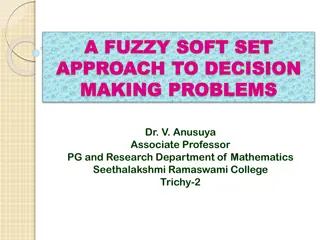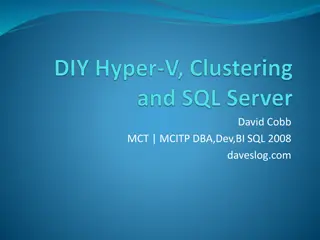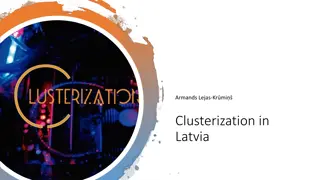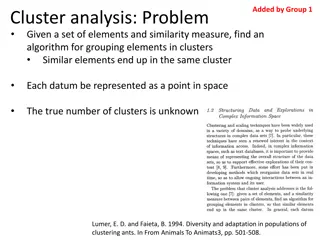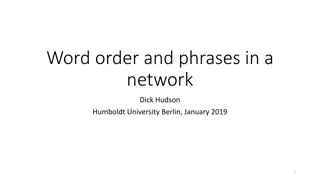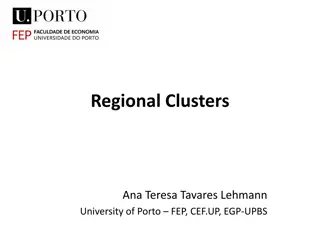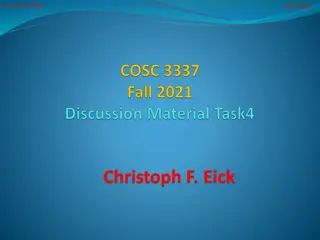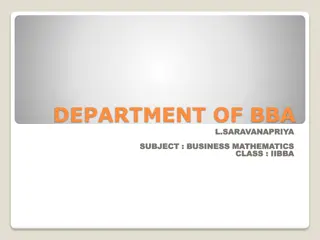Clusters, Bundles, Visual Sets, Priming: Understanding Language Patterns
The concepts of clusters, bundles, visual sets, and priming in language analysis. Learn how words repeat, lexical elements co-occur, and visual items relate in texts. Discover how clusters and bundles can be primed in specific contexts. Dive into a case study on Bundaberg Beer ads and a translation excerpt from "Il Cinema Paradiso."
Download Presentation

Please find below an Image/Link to download the presentation.
The content on the website is provided AS IS for your information and personal use only. It may not be sold, licensed, or shared on other websites without obtaining consent from the author.If you encounter any issues during the download, it is possible that the publisher has removed the file from their server.
You are allowed to download the files provided on this website for personal or commercial use, subject to the condition that they are used lawfully. All files are the property of their respective owners.
The content on the website is provided AS IS for your information and personal use only. It may not be sold, licensed, or shared on other websites without obtaining consent from the author.
E N D
Presentation Transcript
LESSON THREE Clusters, bundles, lexical sets, priming Visual sets Translation
Coherence 1: clusters According to Scott words which are found repeatedly in each other s company (cf. collocation) are clusters.
Coherence 2: bundles Biber (1999) refers to lexical bundles. i.e. the identification of groups (bundles) of lexico- grammatical elements that co-occur with more than usual frequency in particular genres eg. newspaper editorials (present tense, deontic modals, etc.)
Visual sets Similarly, in multimodal texts, visual items will re- occur and co-occur in the same way, and in an integrated relationship with the verbal elements, forming clusters of semiotic modalities. See MCA for an example of a relational database designed to promote the analysis of this phenomenon.
Priming Clusters and bundles can be primed (Hoey) to appear only in specific parts of a text or specific circumstances of discourse production. I love you too.
Case Study Bundaberg Beer ads
Translation Il Cinema Paradiso S , Di Vita Salvatore. Non lo conosce signorina? Io sono la madre. Chiamo dalla Sicilia. E tutto il santo giorno...Ho capito... non c .. Potrebbe darmi... 65622056... Grazie, buongiorno. Mamma, inutile. Ha troppi impegni. E poi non si ricorder pi . Lascia perdere. Ormai sono trent anni che non viene pi qua. Lo sai come fatto, no? Si ricorder , sono sicura! Se sa che non glielo abbiamo detto...vedrai come gli dispiacer .
TRANSLATION FIAT
LESSON FIVE Film Dubbing
Film language Filmese
Acomplex semiotic event In everyday conversation, much language use is in fact formulaic in nature, and much ordinary talk is humdrum and banal, whereas the time and space constraints of films, and the need to relate interesting, exciting or engaging stories, leads to an excess of highly pertinent, dramatic or intriguing exchanges.
"short, sharp and tight" Actual conversation seems to the listener to be extremely garbled with people apparently speaking at the same time, making false starts and so on, while much film dialogue seems to be clearly separated, as actors take their cues with unerring accuracy.
Pleases and thankyous Real dialogue is peppered with phatic devices, particularly repeated pleases and thankyous regardless of whether actual requests, offers or favours are involved.
A lifetime of experience In real life every individual is in fact called upon to play a variety of roles in his or her normal activity, and in some senses follows an unwritten script. Although this is precisely what a film actor is required to do, the real life role is based on a lifetime of experience, responsibility and interaction that the scriptwriter or actor cannot easily invent.
By the way In ordinary dialogue an initial topic of conversation often gives way to a series of sub-topics, or even to totally different subjects, often signalled by markers of the Still..., Ooh... type.
BUT if the actor...spoke as people do in 'real life', with frequent non sequiturs, false starts, allusions, digressions, sentence fragments, etc. ...the audience would be unlikely to be getting the information it needs to get, in order that the 'two hours traffic of the stage (or film) emerges as a whole and understandable experience (Gregory 1978: 43).
Conversation - an ongoing phenomenon Any specific interaction is just one part of a continuing conversation which, strictly, has no absolute beginning or end - only provisional, though decisive, points of opening and closure. Conversation is therefore part of that larger dialogue we call, variously, society, history and culture. (Pope, 1998: 223)
Dramatic.pauses Research has shown that, generally speaking, pauses of one second or more are rare in ordinary conversation, while dramatic pauses in film scenes are often simulated and belie this statistic, through the need to create dramatic pauses.
Come up and see me sometime Major film stars are often given 'good lines' showing how witty, urbane or 'streetwise' they are.
Back to multimodality People never express meaning through only one channel; when speaking they also use gesture, gaze, positioning, etc. Film audiences do not participate directly in the dialogue unfolding on the screen; they are more or less distant observers and cannot be expected to pick up every nuance of non-verbal communication.
Special case of translation Film is a complex semiotic system consisting of verbal and non-verbal components
Dubbing Gr. diplos; lat. dopiare; Fr. doubler; Eng. to double false
Sergio Jacquier quando si ha la sensazione che un film sia recitato in italiano, allora si ha un buon doppiaggio
Research See proceedings of conferences in Forl and Trieste: E.g. Il doppiaggio: trasposizioni linguistiche e culturali Traduzione multimediale per il cinema, la televisione e la scena La traduzione multimediale: Quale traduzione per quale testo?
Research Trieste See proceedings of conferences in Forl and Trieste: E.g. Tradurre il Cinema Emerging topics in Translation: Audio description AD Day
Good and Bad Horse Feathers Many Rivers to Cross/Un napoletano nel far west Friends
Talking Points Film language Levels of predictability Translation (dubbing, subtitling) 1. 2. 3.
Film language Starting from the premise that film language is an artificial product written to be spoken as if not written (Gregory, 1992), we can agree with Marshall and Werndly (2002) that the only reason that characters talk to each other in television texts is so that the viewer can listen to them; not, as in real conversation, so that they can listen to each other ,
APS Thus film language consists of clear-cut cues and guided discourse (cf. Ochs - planned and unplanned discourse). The flow of images is created by film directors, cameramen, set designers, etc. in the construction of an artificial situation. Similarly the language (and grammar) of film is a scripted construct created by screenplay writers and editors, altered by directors and actors, subsequently by dubbing actors, subtitlers, etc. in the creation of an artificially produced situation (APS)
Film language and genre The APS can also be identified in terms of genre. The blanket expression film genre brings to mind such types as western, spy story, comedy, etc. But films have their sub-genres and genrelets.
Seinfeld - The Revenge LEVITAN: Remind me to tell you what we did in Lake George. Get this I got it all on video. (laughing) GEORGE: That s it. This is it. I m done. Through. It s over. I m gone. Finished. Over. I will never work for you again. Look at you. You think you re an important man. Is that what you think? You are a laughing stock. You are a joke. These people are laughing at you. You re nothing! You have no brains, no ability, nothing!. I quit!
Filmese? Compare the language of film with a spoken corpus of English. Bank of English Bergen Etc.
Spoken language Hesitation, repetition, filled pauses, false starts, etc: CRYSTAL Lower lexical density: HALLIDAY Marked neutralisation of unstressed vowels: DOWNING & LOCKE Focus on interpersonal involvement: TANNEN
Spoken language 2 Use of large number of prefabricated fillers, both interactive and planning (eg. so, well) BROWN & YULE Immediacy of context is reflected in a high number of discourse markers (eg. well, right) McCARTHY
Examples chosen NOW WELL RIGHT SO OK YES
Sci-fi 1 -ALIEN (1979) Words 20,291 now well right yes OK 4 so 3 5 4 16 0
Metropolis (1926) now 0 well 2 right 1 yes 4 OK so 1 15
Sci-fi films - total Words 1,014,498 now 270 well 605 right 176 yes 212 OK 293 so 393
Bank of English Words 1,000,000 circa now 620 well 2990 right 3650 yes 3830 OK 1150 so 4800
Comparison sci-fi/corpus 5000 4000 now well right yes OK so 3000 2000 1000 0 Sci-fi corpus
Realistic films - Casino now 20 well 66 right 25 yes 18 OK so 71 55
As good as it gets Words 21,161 now 4 well 31 right 3 yes 4 OK 32 so 39
Realistic films - total Words 995,746 now 377 well 1179 right 260 yes 238 OK 670 so 1032
